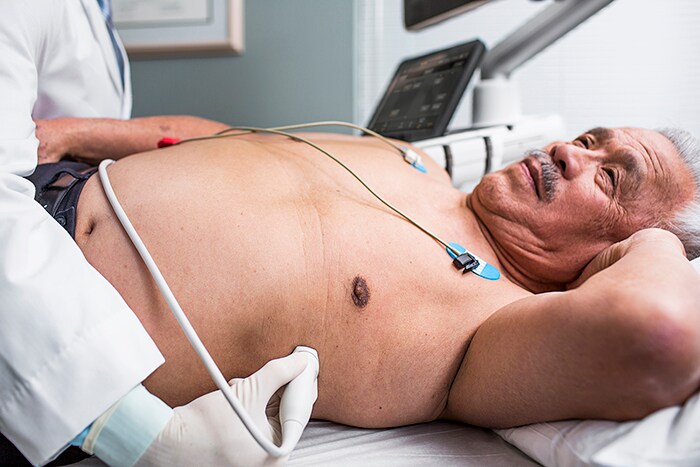Blog
In cardiology, could improving the patient’s timeline hold the key to improving care?
A great deal has changed in cardiovascular care since I was an intern at Cornell University Medical College in the 1990s. Yet today when I work with hospitals around the world as Associate Chief Medical Officer of Philips, I see that one aspect remains core to the field:
The timeline. This chronological overview of a patient’s diagnostic tests and treatments is critical to enabling the clinician to make the best decision for the patient at any given time. In 1990s, the timeline took the form of a physical folder full of notes and scans. Today, it’s more likely to be on screen, yet missing information can be isolated in different parts of a hospital. It makes me wonder: is there a way to bring together these key insights in a deeper, more actionable way? If I think about what my colleagues tell me today about their challenges, it often relates to that timeline in some form or another: • Broken information or communication between events or between teams. • Increasing amounts of imprecise patient data which remain difficult to interpret. • Clinical variation leading to inconsistent or sub-optimal decisions. And with all of these, there’s a cognitive overload that impedes planning and action. The acceleration in generating genetic, pharmacologic, physiologic and other data only deepens the chasm across these challenges. At a time when cardiology is more complex due to patients surviving longer and with more complex comorbidities, medicine needs to identify care pathways that connect data, technology and people more than ever. In this blog, I’d like to look at three ways we could do that.
If I think about what my colleagues tell me today about their challenges, it often relates to that timeline in some form or another.
Tackling information overload across the cardiology service
The first is by tackling information and cognitive overload. Clinicians are spending more time behind computer screens, accessing a variety of programs and tools to ensure they have the complete picture of their patient’s health. This comes as no surprise, since patients often see multiple specialists and have various tests and procedures performed in different areas of the hospital. It can be challenging for various physicians to collaborate and get a fully integrated view of how to manage an individual patient’s health journey. At the same time, patients are burdened with having to recall their care journey and test results. Both would benefit from a more collaborative and holistic approach to care: an approach that collects and organizes information in new ways. At Philips, we collaborated with clinical partners to address this challenge, by creating IntelliSpace Cardiovascular, a web-enabled image and information management system that provides advanced tools for physicians to access, analyze, and share cardiovascular images and information anytime, from virtually anywhere. This solution brings multi-modality images and clinical tools such as EMR data, scheduling systems, and any web-based application, together in a single workspace to facilitate quick and confident insights and clinical decisions. At the heart of IntelliSpace Cardiovascular is the Cardiology Timeline, which delivers a graphical, chronological overview of patients’ cardiovascular care continuum. As an intern, I worked hard to overcome the challenges of collecting and organizing data to create insights that would be used to plan and deliver care optimally. Now the timeline can be presented simply and visually.

Simplifying diagnosis – deeper insights at each point in time
Alongside optimizing care pathways across the cardiology department, we need to improve diagnostic moments within that timeline too. We need to collect and organize data in efficient, more intuitive ways. I’d like to give you an example from echocardiography: Chronic disease populations are growing. Newer interventions in structural heart disease need precise anatomic information to personalize device selection and guidance. Subtle but important changes in cardiac chamber remodeling need to be quantified by a broader range of clinicians and in less time. Heart failure -- whether caused by infarction, chemotherapy, or anything else -- needs to be quantified accurately and trended with newer thresholds of precision as therapies become more effective by being biologically tailored. To deliver an accurate diagnosis of many cardiovascular diseases, clinicians often use 2D ultrasound to quantify the geometry of the heart’s valves and chambers. But studies show that these exams can underestimate results because of image foreshortening and geometrical assumptions (after a heart attack, a heart changes shape). While 3D techniques can overcome this issue, until now they have been heavily operator-dependent due to the challenges in acquiring, interpreting and quantifying the images. A little over a decade ago, during the earlier stages of 3D echocardiography, the technology was developing faster than the clinician’s ability to absorb it. Having such an operator-dependent tool meant that there were only a few people in a department who were up to speed on how to use the new technology.
Alongside optimizing care pathways across the cardiology department, we need to improve diagnostic moments within that timeline too.
We kept this in mind when we developed our cardiac imaging tool HeartModelA.I. Instead of incrementally bolting-on technology, we changed the rules of the game by simplifying the technology and deepening the insights. We developed HeartModelA.I. to be a personalized representation of the patient’s heart. More importantly, by working globally at clinics around the world, we deepened its robustness by tuning the heart’s representation to different heart sizes and shapes. With advances in artificial intelligence (AI), this now happens in seconds with the push of a button. Less time, less complexity, more insight.
The future of seamless care: the digital twin
I believe that HeartModelA.I. is just the beginning. If we fast forward 20 years to 2040, I think the timeline will grow into an even more intuitive form: a digital twin of the patient. Let me explain. As AI improves in the future, it will enable us to take raw data and process it into insights that are deeper, more coherent, arrive earlier and are more actionable than anything I worked with as an intern. We are investing in tools that help use the data for deeper analysis and precision dagnoses.
If we fast forward 20 years, the timeline will grow into an even more intuitive form: a digital twin of the patient.
In cardiology, it is a challenge to risk stratify patients and personalize their care because they have very complex, comorbid pathways that obscure the insights needed to promote healing. With AI solutions, we can start to identify the complex interplay of factors that affect an individual heart failure patient – including the pathways of their heart, lungs, kidneys and neurohumoral biochemistry -- and integrate them holistically within the patient context in order to support the physician in providing clear insights into treatment pathways. At Philips, we’re working on a solution to uncover patterns and trends that may prevent the disease and ultimately help to find new cures. Essentially, we are creating a full model of the patient – a digital twin. But it’s not just the twin of who they are now. It’s the movie of their life, where they’ve come from, and who their parents and grandparents were, which we can read from their genome. And about the diseases and medical events they’ve had in their life, which we can read from images and tests. I think of it as the timeline in its most intuitive form. If we combine this with information about the patient’s lifestyle and behavior, suddenly we can start to become much better at proactively helping patients live healthy lives. And should they become ill, doctors can diagnose them more quickly and precisely in order to find increasingly targeted treatments.
Still a way to go
Of course, we’ve got a long way to go before the digital twin becomes a reality. In a field as complex as cardiovascular care, there are no simple solutions. But I am proud and excited to be part of figuring out where we can go.
If you’d like to find out more about our research work on seamless cardiovascular care, Dynamic HeartModelA.I. and other innovations, visit Philips at the ESC Congress from August 25 to August 29, 2018 in Munich.
Visit the Philips Stand #H200, Hall A3 at ESC to experience our innovative cardiology portfolio. Follow the #ESC2018 conversation with @PhilipsLiveFrom throughout the event.
Author

Ivan Salgo Connect with Ivan on:
Associate Chief Medical Officer at Philips
Ivan believes that innovation cannot happen without passion. His passion is in uniting artificial intelligence innovations with imaging, monitoring and physiology to promote cardiovascular health.
